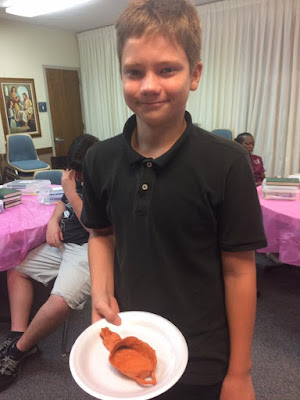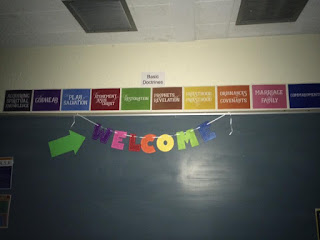This is a fun way to help students learn the Doctrines associated with each Doctrinal Mastery Scripture. It is not my original idea.
This idea is from fellow teacher, Sharon Haynie, who uses marshmallow shooters for her Turkey shoot. Click HERE for directions she shared on how to make Marshmallow shooters.
I use Nerf guns because that is what I have.
You could also use rubber band shooters.
Set Up:
Turkeys on paper plates stapled to upside down large plastic beverage cups. (see photos below)
Inside each cup is written a point amount ( 5, 10, 15, 20, 25, 50)
(I recycled my cups and plates from last year-they come apart easily and store in a small space-I don't like to do double work so anything I can use from year to year is a win!)
Divide students into teams ( I had 4 teams of 3 each-one team had 4 members)
Each team sat together on the perimeter of the "Turkey Coop" (see photos below for set up ideas)
For each round:- Students sit as teams in the chairs set up around the perimeter.
- Each team has a Nerf gun
- Call out the key words or phrases from a Doctrinal Mastery scripture
- Teams work together to locate the scripture ( all team members must turn to the scripture), then a runner comes to me and shows me the scripture and states the Doctrine associated with that Scripture.
- When I confirm it is correct, I say, GO!
- The Team takes their Nerf gun and starts shooting the paper plate turkeys (each round a new team member takes their turn with the Nerf gun-some of them rotated during the same round so they all got more "shooting time")
- Each team does the same to find the scripture and show it to me
- When the last team comes to me with the correct scripture and doctrine, I call out "30 seconds left" and set my timer.
- When I say stop, the teams would bring their turkeys to me and call out the points earned.
- Points are posted on the chalkboard and added up at the end.
- After each round, the turkeys are put back on the tables so we would have enough for each round.
- I would go scramble them sometimes as I could tell the students were catching on to some of the higher point turkeys.
As much fun as this is, the most important point is that the students had to dig into their scriptures match them to the doctrines associated with them. This was very effective.
















































